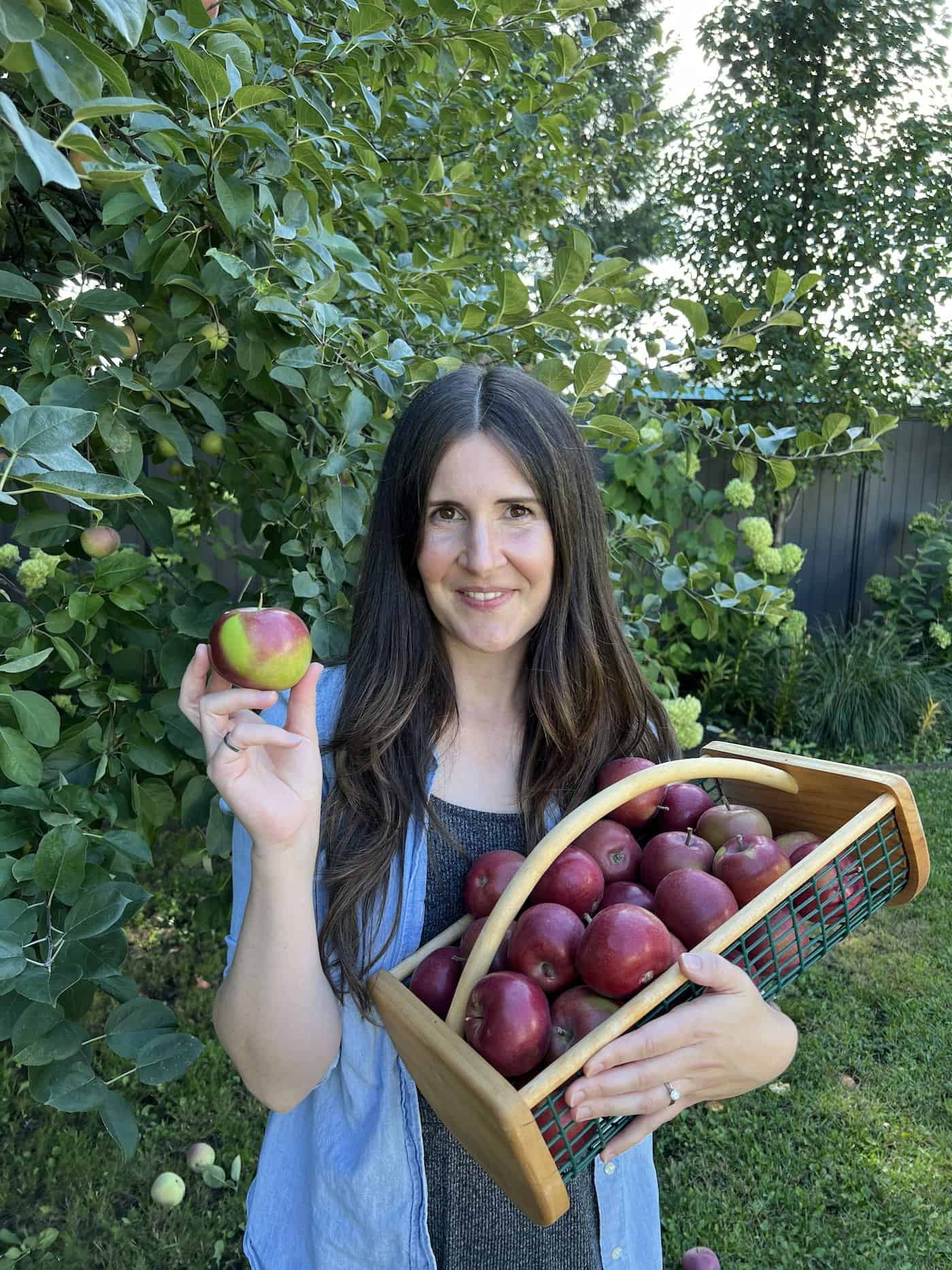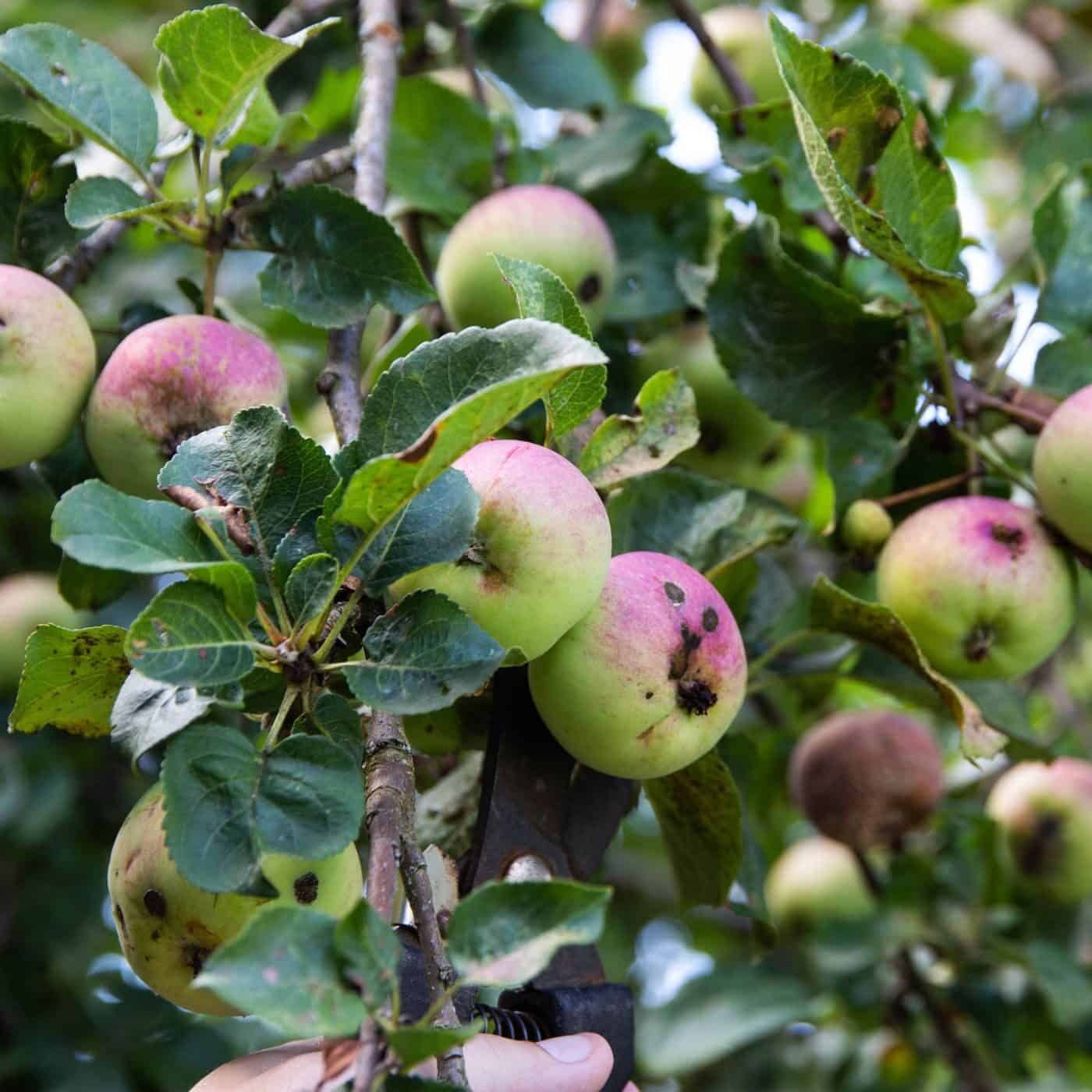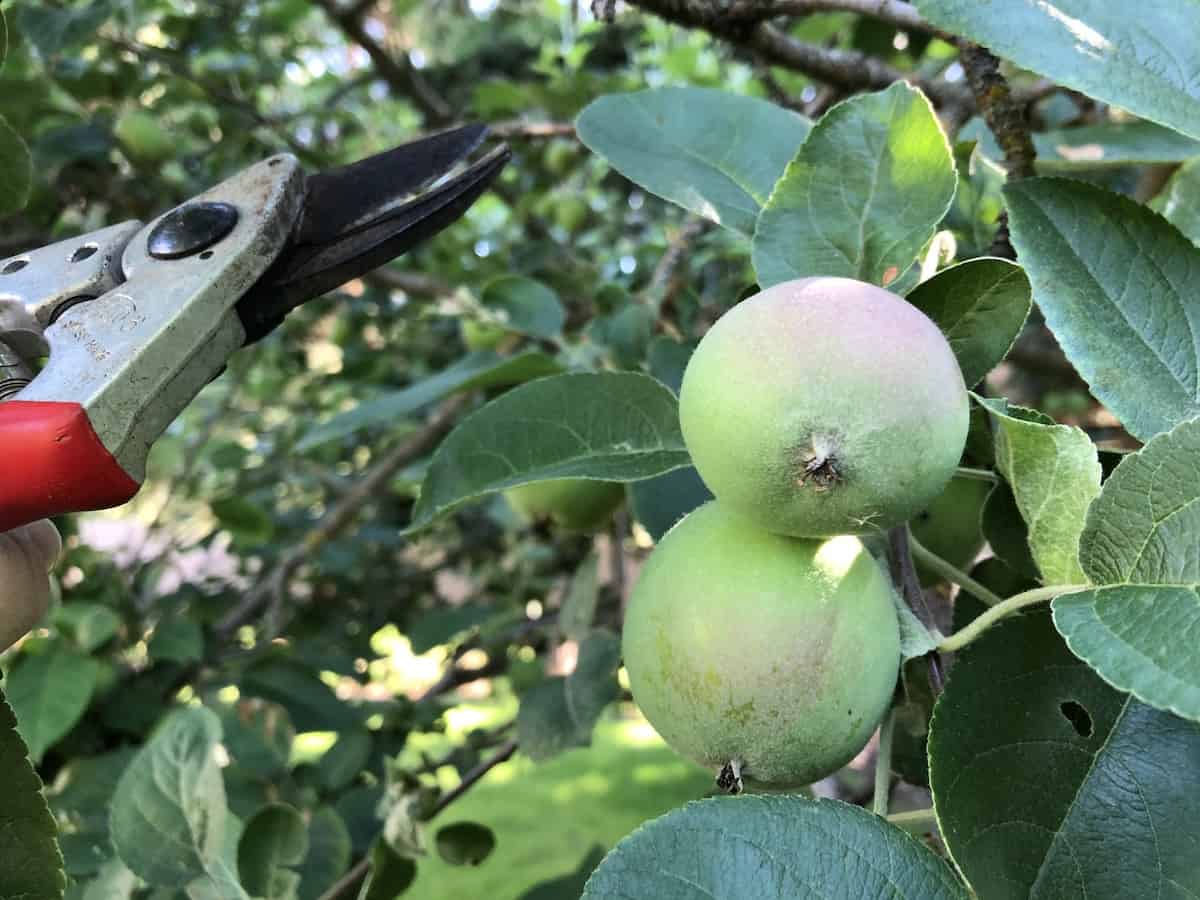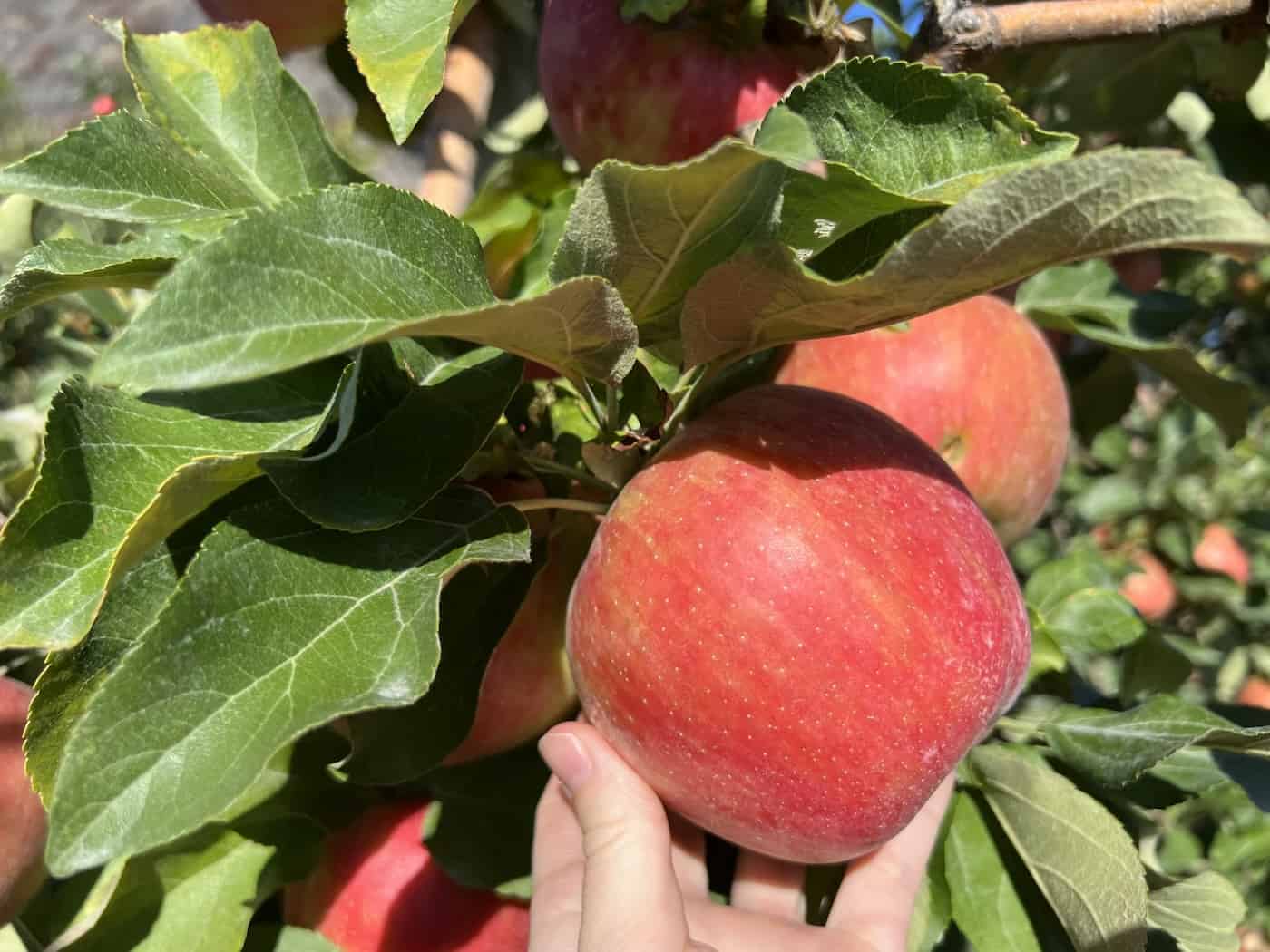Wondering how to grow apples? While it can take a few years, caring for an apple tree is quite approachable (even for beginner gardeners). Let’s look at how you can add apples to your home fruit garden.
The basics of growing apples
Apple trees are relatively easy to grow, but they do need a bit of annual maintenance. If you prune them well when they are young, the annual pruning requirements become much less onerous, so get them off to a good start. Otherwise, they are one of the easier tree fruits to grow in your yard.
Start by choosing a variety based on your favorites for eating, the tree’s disease resistance, and local climate suitability. Always plant apple trees in a sunny spot. Look for an area with moist, well-drained soil, but avoid low or wet spots. Take care to consider irrigation, as you’ll need to water the tree frequently as it becomes established.

Planting can be done from spring to fall. If you plant in the summer heat, you’ll have to water, water! Prune and train your young apple tree (see below) regularly for optimal growth, production of quality fruits, & aesthetics.
You usually need two apple trees to produce fruit, as apples are self-unfruitful. Some varieties, such as Golden Delicious, will produce a crop without cross-pollination from a second variety, but for optimal production, two different apple tree varieties that bloom at the same time should be planted within 50 feet of one another.

Choosing an apple tree variety
Selecting an appropriate apple tree (or trees) for your garden is paramount to enjoy the fruits of your labor. Several factors come into play when making this decision, such as disease resistance, climate suitability, and desired fruit usage.

Desired fruit usage
An essential factor to consider when selecting an apple tree is how you plan to use the fruit. Different types of apples can differ greatly in taste, texture, and storage life, making some better suited for specific purposes such as eating fresh, baking, juicing, making applesauce, or producing cider. Choosing a variety that aligns with your desired fruit usage will enhance the results of your apple harvest.
Some popular apple varieties include:
All of these varieties are excellent for eating fresh. Some are very sweet. Other varieties, like ‘Granny Smith’ and other green-skinned cultivars are more tart and perfect for baking pies or making applesauce. If you’re interested in making cider, consider specialty cider varieties like ‘Kingston Black’ or ‘Dabinett.’
Brand name “club apple” (such as Jazz or Cosmic Crisp) trees can be difficult to find, as the trees are often sold only to licensed orchards. Avoid purchasing unlabelled apple trees or digging up unidentified seedlings.

Many apple varieties also have unique harvest seasons, with early-season, mid-season, and late-season apples ripening at different times of the year. You can enjoy a more extended season of delicious homegrown apples by planting a mix of varieties with different harvest times.

Disease resistance
Additionally, selecting varieties that are naturally resistant to common diseases can help ensure your tree’s longevity and fruit production. Take the time to research different apple varieties and their resistance to local pathogens to find the perfect tree that meets all your needs.
Some disease-resistant apple varieties to consider are:
- Liberty
- Enterprise
- GoldRush

Climate considerations
Selecting a variety that complements your area’s hardiness zone is critical. Most apple tree varieties thrive in cold and humid climates, with cold winters followed by temperate springs and summers. Some varieties, however, are more suitable for warmer climates with mild winters.
Consider the required chill hours of the varieties you’re looking at. Apple trees need a specific amount of chilling during winter to flower and produce fruit properly. You can consult tree tags or ask the seller for chill hour information to ensure you choose a variety that will flourish in your climate.

Understanding apple tree sizes
Apple trees exhibit a variety of sizes. Choosing the appropriate size and form for your apple tree depends on factors such as available space, maintenance requirements, and desired aesthetics. They are generally sorted into the following three categories:
- Standard
- Semi-dwarf
Dwarf
The mature size of an apple tree depends on the type of rootstock the tree has. Most apple trees sold these days are grafted onto semi-dwarf rootstocks, but you can find dwarf trees quite commonly (and standard trees less commonly).
Apple trees sold in nurseries are generally not grown from seeds. The top of the plant comes from a branch of the “mother tree” of a specific variety, and the roots of the plant come from a root piece from a “rootstock” cultivar. The branch of the desired variety is grafted onto the rootstock.
Standard apple trees can grow up to 30 feet tall and wide, requiring 30 feet of spacing between trees in rows 30 to 40 feet apart. These trees produce large quantities of fruit but can be more challenging to manage due to their size.
On the other hand, semi-dwarf apple trees are a more manageable option, growing to about half the size of standard trees and needing 12 to 15 feet of spacing between trees in rows 15 to 20 feet apart.
Dwarf apple trees, which grow between four and eight feet tall, are ideal for small spaces or container gardening and require only 4 to 8 feet of spacing between trees.
In addition to tree size, various training methods can help you manage your apple tree’s growth and shape. Some popular training methods include espalier, cordon, and fan training, which allow you to create space-saving and visually appealing designs. Understanding the diverse sizes and forms of apple trees empowers you to choose the optimal option for your garden, paving the way for a rewarding apple-growing experience.

Where to plant an apple tree
Selecting the ideal planting location for an apple tree is essential to ensure its growth, health, and productivity. The ideal planting location for an apple tree is sunny, spacious, and well-draining with good air circulation. Proper site selection can lead to healthier trees, bountiful harvests, and fewer pest and disease issues.
Sunlight
Apple trees require full sunlight to thrive. They should receive at least 6 to 8 hours of direct sunlight daily. Sunlight boosts flower and fruit development and helps prevent diseases by quickly drying off moisture from leaves and fruits.
Soil
Most importantly, the soil should be well-draining. Apple trees dislike standing water, which can lead to root rot and other complications.
While apple trees can tolerate a range of soil types, loamy soil, which is a balanced mix of sand, silt, and a bit of clay, is ideal. Before planting, enriching the soil with well-decomposed compost or organic matter can be beneficial.
Ideally, the soil pH should be slightly acidic to neutral, in the range of 6.0 to 7.5. Amend the soil to adjust pH before planting if possible.
Space for the mature tree
Apple trees need ample space to grow and spread out. While the exact space varies depending on the variety and rootstock, standard-sized apple trees typically require about 20-25 feet of spacing between each tree. Dwarf or semi-dwarf varieties will require less space, often between 10-15 feet.
Plant apple trees away from buildings, septic tanks, underground utilities, and large rooted trees. This ensures the tree has ample space to expand its root system without interference and reduces competition for nutrients and water.
Air circulation, wind, and frost considerations
Good air circulation helps in preventing fungal diseases. Planting in an open area or on a gentle slope can ensure that cold air (which is denser) moves away from the tree, reducing the risk of frost damage in spring.
Ideally, the site should be somewhat protected from very strong winds, which can break branches or even uproot young trees. If you live in a particularly windy area, consider using windbreaks or barriers to shield the trees.
Avoid low areas where cold air settles, leading to frost pockets. These areas can damage the blossoms in the spring.
Pollination
Most apple varieties are not self-pollinating, meaning they require pollen from another apple variety to produce fruit. Ensure that there is another suitable pollination partner apple tree variety nearby for cross-pollination unless you’re planting a self-fertile variety. Work with your local nursery to choose suitable pollination partner trees that tend to bloom at the same time in your climate.

Planting an apple tree
Apple trees are typically best planted during spring or autumn, depending on your region’s climate. That said, you can plant any time of year as long as the ground isn’t frozen. Just take care to keep the soil consistently moist (but not wet/muddy) in the entire area for the first year or two after planting.
Dig a planting hole that is six inches larger than the pot size in diameter. The depth of the hole should be between eighteen and two feet. Place the tree’s roots in the hole, ensuring the graft union (where the scion and rootstock meet) sits above the soil line. Backfill the hole with soil, firming it down gently to eliminate air pockets. Water the tree thoroughly after planting and continue to provide it with one inch of water per week during the growing season.
Soak the roots in water for a few hours before planting if your tree is bare-root. For container-grown trees, gently remove the tree from its container without damaging the root ball. Stake the tree if the tag indicates that support is needed to protect it from strong winds.
Caring for apple trees
Apple trees take time to become established and start producing fruit. It may take a few years for your young apple tree to bear fruit, but you’ll soon enjoy a bountiful harvest with proper care and maintenance.
Pollination
The success of your apple tree significantly depends on pollination and cross-pollination. The majority of apple trees require cross-pollination from another tree to bear fruit. To ensure the best possible fruit production, it’s essential to understand these processes and plant multiple apple tree varieties in your garden. You’ll also want to work to attract pollinator insects to your garden.
Pollination is the process of transferring pollen from one tree to another, while cross-pollination is when pollen from another apple tree is required for a given tree to produce fruit. Based on their blooming time, apple trees are divided into three flowering groups, A, B, and C. Planting two or more apple trees in the same group guarantees pollination and helps your trees produce a more abundant harvest.
In some cases, you might encounter a triploid apple tree variety, which has three chromosomes and requires two additional sources of pollen to yield fruit. In this situation, planting at least three trees together is necessary to provide sufficient pollen for the triploid tree.

Pruning apple trees
Your apple tree requires regular pruning and training for optimal growth, fruit production, and aesthetics. Regular pruning helps maintain a balanced tree structure, removes dead or diseased branches, and encourages better fruit production. The season in which you prune affects how the tree responds to your pruning
Winter pruning
Winter pruning focuses on structural and maintenance pruning for apple trees. Structural pruning helps shape and maintain the tree’s overall form, while maintenance pruning removes dead or diseased wood and promotes fruit production. It also makes the tree grow more vigorously.
To ensure proper winter pruning, follow these steps:
Use sharp pruning shears and make precise cuts.
Start by removing any dead or diseased branches.
Shape the tree by eliminating any crossing or rubbing branches.
Winter pruning should be performed annually in late winter or early spring when the tree is dormant. Proper pruning during this time can improve fruit production, increase air circulation, and enhance light penetration within the tree.
Summer pruning
Summer pruning is another essential aspect of maintaining your apple tree’s health and appearance. This type of pruning helps control growth and maintain the desired shape of the tree. During summer pruning, focus on cutting back new shoots to allow more light to reach the fruit, which can improve fruit production.
To perform summer pruning effectively, follow these tips:
Use sharp pruning shears and make precise cuts.
Prune in the early morning or late evening when temperatures are cooler.
Avoid pruning too much at once, as this can stress the tree.
Training methods
In addition to pruning, training your apple tree can help create a more visually appealing and functional form. Some popular training methods include espalier, cordon, and fan training. These techniques can be used to create space-saving and attractive designs in your garden, particularly if you have limited space or wish to add a decorative element.
Espalier apple tree training involves cultivating a tree with a central vertical trunk and tiers of horizontal branches radiating from the central leader. Cordon apple tree training focuses on training a single stem to grow along a horizontal wire or cord. Fan apple tree training involves training the branches to grow in a fan-like configuration.
Thinning apples
To ensure larger and healthier fruits, thinning apples is a vital process. Removing some immature fruit from the tree allows the remaining fruit to grow larger and receive more nutrients. Overcrowded apples can result in smaller fruit, strained tree limbs, and even reduced crop yield in the following year.
An appropriate time to thin apple trees is a week or so after the “June drop,” a natural thinning process where the tree adjusts its crop load to what it can bear. If you anticipate the tree may struggle to support its fruit load, manual fruit thinning becomes necessary. To do this, remove excess apples, leaving about 4-6 inches of space between each fruit.
Thinning apples not only helps improve fruit quality but also helps maintain the overall health and stability of your apple tree. So, be sure to give your apples adequate space to grow and flourish!

Pest and disease management
Maintaining a healthy apple tree significantly relies on effective pest and disease management. Common pests and diseases that can affect apple trees include:
- Apple maggots
- Codling moths
- Apple scab
- Fire blight
- Plum curculios
- Green fruit worms
- Cedar apple rust
Prevention is key in managing pests and diseases. Regularly inspect your apple tree for signs of infestations or infections, and address any issues promptly. You can also employ organic sprays to deter pests and manage diseases, such as applying insecticidal soap, neem oil, or homemade solutions like vinegar and sugar mixtures to repel insects.

Harvesting and storing apples
On average, apple trees will begin producing fruit between 2-8 years after planting, depending on the variety of trees you choose to grow. Grafted trees tend to fruit much earlier than seed-grown standard trees.
When your apple tree starts to bear fruit, learning the correct time and methods for harvesting and storing your apples becomes important. Harvesting at the right time and using proper techniques will ensure that you enjoy the best possible quality and flavor from your homegrown apples.
To determine when your apples are ripe and ready for harvest, look for sweetness, fruit size, and color indicators. It’s best to wait until the green on the apple’s skin has completely faded before harvesting.
When picking apples, gently grasp the fruit and turn it upside down. The saying is, “eye to the sky”. Don’t pull the apple off or twist the stem. This can damage the apple and also perhaps cause nearby apples to fall off and hit the ground. Avoid tugging down on branches or forcibly plucking the apples, as this can damage the tree.
Once you’ve harvested your apples, store them in a cool, dark place like a refrigerator. Proper storage conditions will help preserve the freshness and flavor of your apples, allowing you to enjoy your homegrown harvest even after the season has passed.







